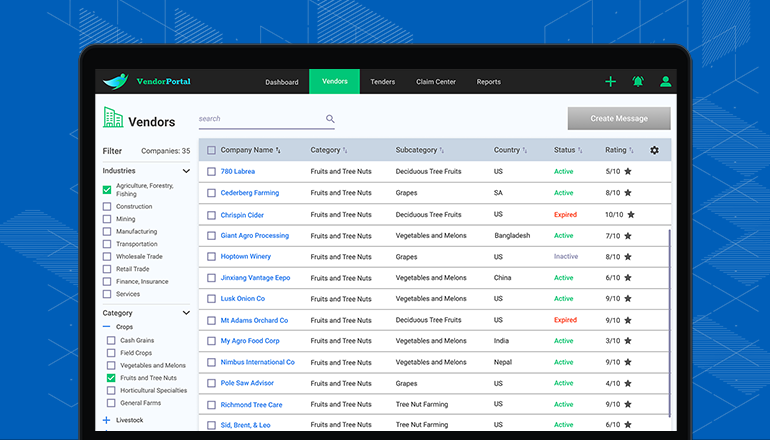B2B Vendor Portal Demo
A B2B vendor portal is a trending solution to build a strong connection with your suppliers and efficiently manage the purchasing process. We’ve developed a B2B vendor portal demo to show you how faster and smoother the communication with your vendors can be with portal implementation.
How Does a B2B Vendor Portal Support Your Business?
The digital transformation of your purchasing department may well contribute to the success of your business. The demo shows how B2B vendor portal implementation can facilitate the two core processes that a purchasing team deals with:
Superior vendor management
A B2B Vendor portal contributes to building a strong relationship with your vendors allowing you to keep vendor data organized and easily accessible, get away from slow paperwork and email-based communication and manage interactions with your suppliers with ease and speed.
- Get access to all vendor data at any time and from any location.
- Engage the right vendors with carefully considered onboarding forms that define your specific requirements.
- Eliminate errors and miscommunications and save valuable time of your vendor managers with vendors’ self-registration process.
- Keep yourself informed about all updates and changes in underlying data (e.g. vendor profile, bid-related info) with alerts and personal/bulk notifications.
- Get quick insights about companies and their products easily navigating through vendor profiles and catalogs.
- Reach better visibility through the history of all interactions with your vendors.
Advanced bidding
The features of a B2B vendor portal can greatly simplify the bidding process and help you make considered decisions.
- Quickly select the appropriate vendors with multiple search options and invite them to participate in the bidding. Now there is no need to spend time looking through countless catalogs and pricelists and making follow-up calls on basic questions.
- Consolidate all bid-related info in one place, including essential documentations (examples of shipping documents, customs duties, if needed), details about all bidders.
- Make considered awards allowing the system to compare responses and find the best offers for you.
- Facilitate future decisions rating the service after the purchase.
How to Maximize the Value of Your B2B Vendor Portal
|
|
Structure the information for vendorsA vendor portal should serve as a single source of all the necessary information, allowing suppliers to easily access cooperation terms, documents, templates, and updates. A well-organized portal structure ensures quick navigation and prevents frustration and inefficiencies. |
|
|
Implement e-sourcing featuresIntroducing e-tender and e-auction features in the portal reduces the time and effort spent on sourcing and broadens access to new suppliers, including those in remote locations. E-sourcing tools simplify tender publishing, bid evaluation, and negotiation while ensuring transparent supplier selection. |
|
|
Ensure visibility of the entire supply processVendors and buyers should have real-time access to the up-to-date order, fulfillment, shipment, and delivery statuses. Complete visibility into the supply chain events makes control and decision-making more efficient for both parties, minimizing uncertainties, delays, and missteps. |
|
|
Integrate the portal with buyer and supplier systemsIntegration with buyer-side systems like ERP or MRP lets procurement teams manage supplier interactions using the systems they already know, which reduces a learning curve and improves workflow accuracy. Connecting the portal to vendors’ inventory, order management, and logistics systems enables automated updates on supply progress and contributes to higher supply chain transparency. |
Supplier expertise can be invaluable in accelerating the R&D process. For example, a while ago, Fuji-Xerox successfully reduced its product development cycle from 38 to 29 months. The secret was that, among other things, they brought their multifunctional teams together, actively listened to supplier insights, and maintained an open exchange of information. By equipping your portal with online collaboration and data-sharing tools, you can create a “one-room” environment that fosters instant information flow and real-time ideation, driving faster, more efficient, and profitable product development.
Common Pitfalls of Vendor Portal Implementation and Ways to Sidestep Them
Challenge #1: Inconvenient UX/UI of the vendor portal
It is not an easy task to hide the complexity of navigating possible supply scenarios, sophisticated pricing algorithms, recurring orders, and multi-tier delivery schedules. However, any inconvenience would bring you back to the basic problems that a portal is supposed to solve. If users struggle to find what they need quickly, they resort to calling and emailing. This undermines the portal’s purpose and results in wasted time, delays, and reduced productivity for both vendors and buyers.
Solution
Challenge #2: High barriers for new promising vendors
Significant integration efforts and entry-level fees can prevent smaller vendors from adopting the portal. Moreover, financial barriers to entry can deter new suppliers who may offer unique advantages that existing vendors do not provide.
SOLUTION
Challenge #3: Lack of transparency and human touch
Over-automation and a lack of human feedback can make the relationships between the partners pallid and bleached and turn the vendor portal into a rigid self-service tool. Plus, opacity across cooperation terms, pricing, and upcoming procurement events can create confusion and erode vendor trust.


